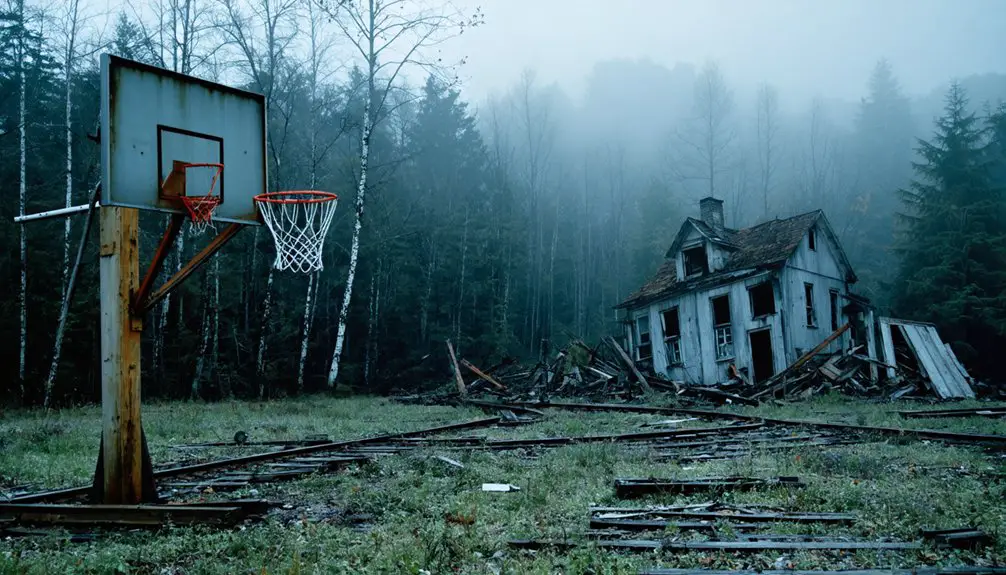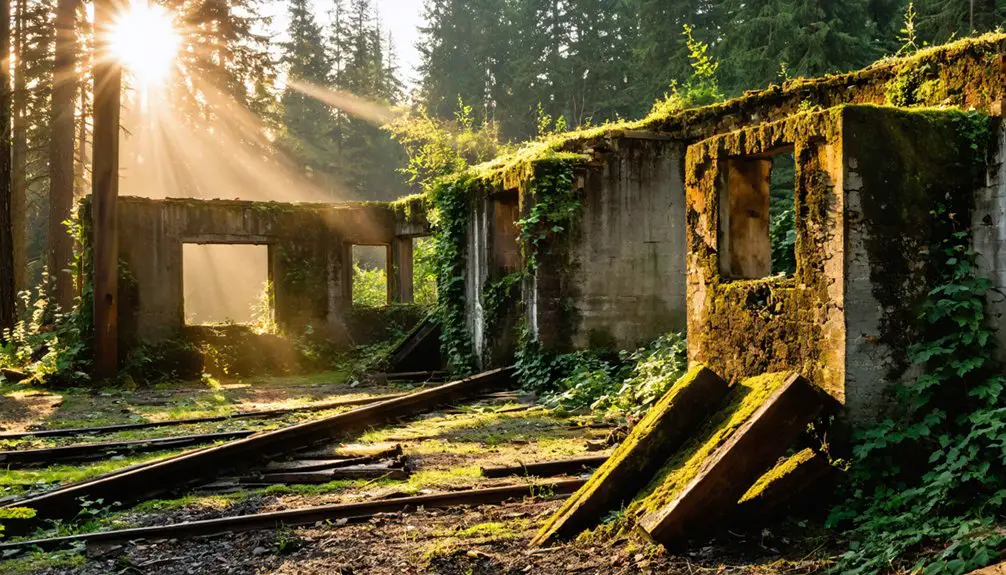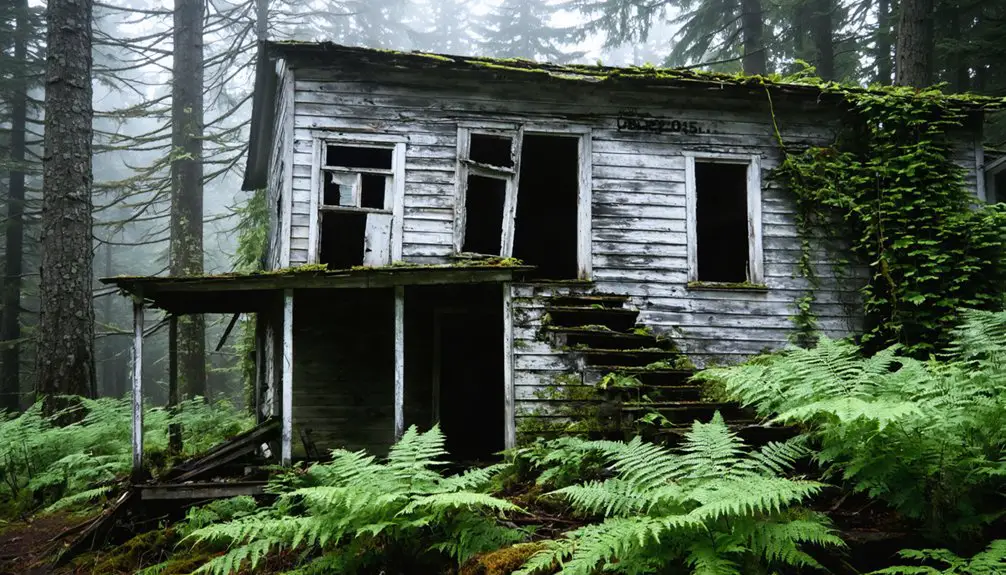You’ll find Valsetz’s ghost town legacy deep in Oregon’s Coast Range mountains, where a thriving company town once supported over 1,100 residents around a bustling sawmill. Founded in 1919 by Cobbs and Mitchell Timber Company, Valsetz flourished with schools, housing, and an essential railroad connection until 1984, when declining timber resources forced its closure and demolition. While nothing remains but scattered foundations, the town’s remarkable story of resilience and community spirit endures.
Key Takeaways
- Valsetz was a thriving Oregon company town founded in 1919 by Cobbs and Mitchell Timber Company around a sawmill operation.
- The town supported up to 1,500 residents with housing, schools, and recreational facilities until its closure in 1984.
- Located in Oregon’s Coast Range, Valsetz received extreme rainfall of up to 120 inches annually and was accessible by railroad.
- Economic decline began mid-20th century due to diminishing timber resources and reduced railroad service, leading to the town’s abandonment.
- Today, only foundations and street grid patterns remain, with the site transformed back into forestland after buildings were razed in 1984.
The Birth of a Timber Town
As timber companies sought to establish permanent logging operations in Oregon’s Coast Range mountains after World War I, the Cobbs and Mitchell Timber Company founded Valsetz in 1919 as a company town centered around a new sawmill.
You’ll find that this strategic move in timber industry development addressed a critical shift from itinerant bachelor loggers to family-oriented workers. The town, named after the Valley and Siletz Railroad that served it, quickly established essential infrastructure including housing, a post office by 1920, and company facilities featuring Tudor revival architecture. The design incorporated jerkinhead roofs characteristic of the period’s architectural style.
The remote location, while challenging to access, proved ideal for extensive timber harvesting. Community development focused on practicality, with carefully planned streets and services supporting the mill operations. This self-contained settlement marked a new era in Oregon’s logging operations. The area’s notorious 120 inches of rainfall annually created unique challenges for residents and workers alike.
Life in the Valley of Giants
In the Valley of Giants, you’d find a unique community where over 1,100 residents lived harmoniously among towering Douglas firs and Western hemlocks dating back to the 1500s.
Children who grew up in Valsetz experienced an extraordinary childhood, attending school within sight of ancient forests while their parents worked in the surrounding timber operations. The record annual rainfall of 120 inches made life in the logging town particularly challenging. Among these majestic trees stood Big Guy, a massive Douglas-fir that towered 230 feet high with a remarkable girth of 36.5 feet.
The abundance of natural resources supported not just the town’s economy but also fostered a distinctive way of life where families shared meals at the company cafeteria and shopped at the local store, all while being surrounded by some of Oregon’s most magnificent old-growth forest.
Valley’s Unique Community Spirit
While many company towns struggled to foster genuine community bonds, Valsetz developed a uniquely resilient spirit that set it apart from typical lumber settlements. You’d find families deeply connected through shared experiences, from daily train commutes to mill work to children’s forest adventures. The old-growth forests surrounding the town provided a natural playground for generations of children growing up in Valsetz.
Unlike transient logging camps, Valsetz’s stable family environment created lasting neighborly ties that helped residents thrive despite their isolation. Their dedication to education shone through their championship basketball teams that brought the community together with pride.
The town’s social fabric was strengthened by creative initiatives like Dorothy Ann Hobson’s newspaper, which gave voice to local stories and reached audiences beyond the valley.
Though the company controlled most aspects of daily life, you’d witness how residents built meaningful connections through community activities, mutual support systems, and collective pride in their forest-bound home.
Children Growing Among Trees
Life for young residents of Valsetz unfolded amid a remarkable rainforest setting, where annual rainfall reached up to 10 feet and towering trees created a natural playground unlike any other.
You’d find children leaping across felled logs near the lumber mill, engaging in childhood adventures that merged industrial and natural elements into their daily play.
The forest exploration became an integral part of growing up, as you’d witness kids freely roaming the dense woodlands with their neighborhood friends.
The two-lane bowling alley provided indoor entertainment during the wettest days of winter.
While the town offered organized activities like football near old “blitz bottles,” it was the unstructured outdoor play that defined their experiences.
The close-knit community, shaped by the small population and company town structure, provided a unique backdrop where children thrived despite the persistently wet conditions.
Living Within Nature’s Bounty
Standing sentinel over the Oregon Coast Range, the Valley of the Giants presents a remarkable 51-acre sanctuary of old-growth forest where Douglas firs and Western hemlocks tower above 200 feet.
You’ll witness nature’s resilience in these ancient groves, where trees up to 500 years old have withstood centuries of change, creating a testament to the region’s timber legacy. Near the abandoned town of Valsetz shut down in 1984, this preserved area now serves as a living museum of Oregon’s natural heritage. The area receives an astounding 200 inches of rainfall annually, supporting its lush ecosystem.
- Massive tree trunks require five people to encircle them with joined arms
- Rich biodiversity thrives in moss-filled bark and unique microhabitats
- Fallen logs create essential pools in streams for native fish
- The forest helps regulate water flow and temperature for local ecosystems
These giants stand as living symbols to the wild spirit of Oregon’s Coast Range, offering you a glimpse into an ecosystem that once dominated the Pacific Northwest.
Railroad Days and Economic Prosperity
You’ll discover that Valsetz’s growth was inextricably tied to the Valley and Siletz Railroad, which began construction in 1913 and reached the town by 1920.
The railroad’s 40-mile line connected the remote timber operations to Southern Pacific at Independence, transforming isolated forestland into a thriving economic hub. The company maintained its shops in Hoskins, where all maintenance and repairs were conducted.
Through this steel lifeline, Valsetz’s lumber industry flourished, with the railroad facilitating both raw log transport and processed timber shipments while simultaneously supporting the town’s essential passenger and mail services until 1952.
Rail-Driven Town Growth
As the Valley and Siletz Railroad extended its reach in 1912, Valsetz emerged as a quintessential company town driven by rail-based timber operations. The railroad infrastructure became the lifeline of this remote settlement, transforming it from wilderness into a bustling logging community by 1920.
- The town’s layout centered around rail facilities, with company headquarters and housing strategically positioned near the tracks.
- Railroad spurs facilitated direct log loading from mills, maximizing timber transportation efficiency.
- Vital services, including a post office, grew alongside the rail development.
- Passenger and mail services connected workers to the outside world until 1952.
You’ll find that Valsetz’s growth mirrored the railroad’s expansion, as the rail network provided essential access to timber markets and supported a thriving workforce community in this otherwise isolated location.
Connecting Markets Through Steel
When the Valley and Siletz Railroad began operations in 1912, it forged significant market connections that transformed Valsetz’s economic landscape.
You’d have witnessed the railroad’s rapid expansion from 12 to 40 miles by 1920, creating unprecedented market access for the region’s timber and agricultural products.
The railroad’s strategic integration with the Southern Pacific network revolutionized transportation legacy in the Coast Range.
You’ll find that this essential link enabled year-round shipping of lumber, breaking free from seasonal constraints of river transport.
Through the construction of specialized infrastructure, including the Willamette River log dump spur, the railroad efficiently connected continental forest resources to broader markets.
Until 1952, the line also carried passengers and mail, ensuring Valsetz’s residents maintained significant connections to the outside world.
Lumber’s Golden Transportation Era
The establishment of Valsetz in 1919 marked the beginning of a remarkable period of railroad-driven prosperity in Oregon’s Coast Range.
You’ll find the Valley & Siletz Railroad served as the lifeline for lumber transportation, connecting remote timber stands to lucrative markets. This 40-mile rail network transformed the region’s timber economy, enabling efficient harvest and transport while supporting a thriving community of over 1,100 residents by the 1950s.
- Railroad operations facilitated both passenger service and mail delivery until 1952
- Multiple rail connections supported robust export capabilities
- Company-owned housing and amenities sustained the workforce
- Strategic rail spurs, including the Willamette River log dump, maximized operational efficiency
The rail-timber partnership created unprecedented economic opportunities, turning Valsetz into a symbol of industrial achievement and community development in Oregon’s logging industry.
A Community Built on Sawdust
Sawdust formed the literal and economic foundation of Valsetz, a remote Oregon timber town established in 1919 by a local logging company.
You’d find the community’s heart beating in its sawmill operations, where workers processed timber from the surrounding Coast Range mountains. The powerhouse burned sawdust and wood waste to fuel the town’s activities, while the massive mill pond, created by damming the South Fork of the Siletz River, supported the timber legacy that defined daily life.
Sawmill operations powered Valsetz’s spirit, transforming mountain timber while sawdust fueled the town’s industrial heartbeat.
In this isolated haven, you’d discover a self-sufficient community of up to 1,500 residents living without municipal police or strict regulations.
The company provided everything – from housing and schools to a bowling alley – creating a unique society where the boundary between work and life blurred beneath the sawdust-filled air.
The Final Whistle Blows

As timber resources dwindled and logging operations declined in the mid-20th century, Valsetz’s economic lifeline began to unravel.
The reduction in train service and eventual cessation of passenger operations in 1952 marked the beginning of the town’s isolation.
You’ll find the economic decline accelerated as the Valley and Siletz Railroad gradually abandoned its routes, including the essential log dump spur in 1958.
- The post office’s closure in 1984 officially marked the town’s end
- Rail service termination left residents with limited transportation options
- Mechanization reduced the need for large workforce
- Families were forced to relocate as jobs disappeared
What Remains Today
Today’s visitors to Valsetz’s former location will find little evidence of the once-thriving lumber town, as officials ordered all buildings razed and burned following the last resident’s departure in 1984.
The only physical remnants you’ll spot are the ghostly street grid patterns etched into the terrain and scattered mill foundations that hint at the site’s industrial past.
Environmental changes have transformed the landscape dramatically.
Nature’s relentless power has reshaped what once was, leaving no trace of humanity’s former presence in this transformed space.
Where homes and businesses once stood, you’ll now find systematic rows of planted trees mixing with patches of old-growth forest.
The Valley and Siletz Railroad tracks have vanished, along with all transport infrastructure.
While you can still access the area via primitive forest roads, you won’t find any historical markers or facilities – just reclaimed forestland where a community once flourished.
Preserving Valsetz Memories

Though physical traces of Valsetz have largely disappeared, dedicated preservation efforts keep the town’s legacy alive through diverse media and personal accounts.
Through oral histories and documentary preservation, you’ll find a rich tapestry of memories that paint a vivid picture of this once-thriving logging community.
- Former residents share firsthand stories at local reunions, keeping community connections strong
- Historical societies maintain extensive collections of photographs, maps, and company documents
- Documentaries and online videos provide thorough visual histories of the town
- Artistic expressions like poems, songs, and commemorative projects honor Valsetz’s heritage
While access to the former townsite remains restricted, these preservation efforts guarantee that Valsetz’s story endures for future generations, despite challenges like the complete demolition of physical structures and the gradual dispersal of former residents.
Frequently Asked Questions
Did Any Major Fires or Natural Disasters Affect Valsetz During Its Operation?
Hold your horses – there’s no evidence of any fire impact or disaster recovery needed during Valsetz’s operation. You’ll find records show the town avoided major natural disasters until its planned demolition.
What Was the Average Wage of Sawmill Workers in Valsetz?
You won’t find exact sawmill wages for Valsetz in historical records, though labor conditions shifted from stable employment in early decades to declining wages and job security by the 1980s closure.
Were There Any Notable Crimes or Law Enforcement Issues in Valsetz?
You’d find crime incidents were virtually non-existent, except for occasional poaching. With no formal law enforcement presence, the company town’s isolation and private land status naturally deterred criminal activity.
What Wildlife Species Were Commonly Encountered by Valsetz Residents?
You’d regularly spot black-tailed deer, elk, black bears, and bald eagles in local wildlife sightings. The area’s rich local fauna included spotted owls, steelhead trout, and various mustelids like weasels.
Did Any Famous People or Celebrities Ever Visit Valsetz?
You won’t find any documented celebrity sightings or famous historical visitors to Valsetz – its remote location, company-controlled access, and lack of amenities kept it focused purely on logging operations.
References
- https://www.youtube.com/watch?v=iqnj-G3bC-s
- https://www.youtube.com/watch?v=y6rVq7Gd-qg
- https://www.oregonhistoryproject.org/articles/historical-records/valsetz-1928/
- https://www.mvbb.info/northerntier/valsetzquadrangle/vq-places/valsetz
- https://sos.oregon.gov/archives/exhibits/ghost/Pages/logging-valsetz.aspx
- https://offbeatoregon.com/H106_Valsetz.htm
- https://nwoverlandquest.wordpress.com/2017/02/18/valsetz/
- https://www.blm.gov/visit/valley-giants-outstanding-natural-area
- https://en.wikipedia.org/wiki/Valley_of_the_Giants_(Oregon)
- https://en.wikipedia.org/wiki/Valsetz



